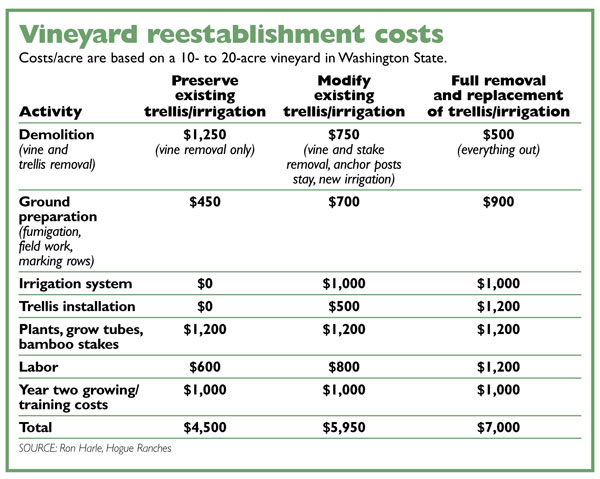When replanting an existing vineyard, a grower has three scenarios to choose from—replace plants and preserve existing trellis and irrigation systems, replace plants and modify existing trellis and irrigation, or remove and replace everything. Each replant situation is different, but replant costs can be significant and are an important factor in the decision process.
General manager of Hogue Ranches and Mercer Estates Winery Ron Harle shared a cost analysis of three replant scenarios, each of which has been done at Hogue. In the last decade, Hogue, based in Prosser, Washington, has spent considerable effort replanting Yakima Valley vineyards, including Cabernet Sauvignon grapes, that were located in sites not well suited for the variety.
In some vineyards, they have removed everything and started from scratch, while in others, they replanted following the modified scenario of replacing vines and modifying the trellis without making row or orientation changes. “Oftentimes, we would have liked to have moved the rows a little closer together from the existing site, but it wasn’t worth investing another $1,000 per acre to do so,” he said.
Harle noted that when deciding which replant scenario to follow, labor availability should be taken into consideration.
Trade-offs
Each scenario has its trade-offs, he said. For example, when preserving the existing trellis and irrigation systems, the only thing that can be changed is the grape variety. “You’re basically pulling out the old vine and putting a new plant in its place, while trying not to damage the irrigation and trellis systems.”
Preserving the existing vineyard setup works best on young vines, he said, adding that while it can be done in older blocks, the effort will require more labor to save the materials. While the cost of preserving the existing setup is the least of the three scenarios, the downside is that row and vine spacing and orientation cannot be changed. “Also, fumigation can only be done through the drip line, so you’re using less effective fumigation than having a custom applicator shank it into the soil.”
When modifying an existing vineyard, salvage is the focus, Harle said. “You’re trying to salvage as much trellis material as you can, while knowing that you are going to upgrade to drip irrigation.” He recommends discarding the trellis wire instead of trying to reuse it, eliminating the labor and frustrations of dealing with unavoidable kinks in the used wire.
Under the modification scenario, with the trellis stakes and wires removed, larger tractors can be used in between rows to allow some ground work, such as deep ripping, and soil-injected fumigation, to be done. “Costs for modification are in the midrange of the three scenarios, and you’re able to change variety, vine spacing, and irrigation, but not row spacing or orientation.”
 Full removal of a vineyard is the most expensive replant option. “You’re incurring all the costs of a new vineyard, but you also have the costs of the demolition and removal of the old one,” Harle said. Demolition costs for full removal are the least of the three scenarios because nothing is preserved. Groundwork costs are more for full removal than the other two options, but also includes things like marking new rows. Labor for the full removal is also the most expensive because it involves putting in a new trellis and irrigation system.
Full removal of a vineyard is the most expensive replant option. “You’re incurring all the costs of a new vineyard, but you also have the costs of the demolition and removal of the old one,” Harle said. Demolition costs for full removal are the least of the three scenarios because nothing is preserved. Groundwork costs are more for full removal than the other two options, but also includes things like marking new rows. Labor for the full removal is also the most expensive because it involves putting in a new trellis and irrigation system.
Though more expensive, the full removal gives a grower a fresh start in reconfiguring the vineyard, he said.
The costs of plants and planting material are the same under all three scenarios of Harle’s analysis. Labor needed for vine growth and training in the second year is also the same in all three options.
Going without a contract
“The most expensive replant is definitely one that didn’t need to happen,” said Harle, adding that winemakers are quick to respond to a fickle wine market and ask growers to jump from one “hot” variety to the next. “We know that as a grower, no matter what we do, sooner or later a winemaker will come out to the vineyard and ask us to change it again.”
There are times when a grower with a variety waning in popularity should consider going without a winery contract for a few years, giving the market time to turn around, he said during a session on vineyard replanting at a statewide wine grape meeting. “Through the years, we’ve taken out a lot of Riesling and put it back in, and taken out Chardonnay and put it back in.”
It’s a hard decision, but Harle has gone without a contract for up to five years, waiting for the market to change. “The fifth year is pretty shaky…and you have to plan on losing about $1,500 per acre for a few years as you find other options for the grapes.” But if the vineyard is healthy and the variety is in the right site, waiting the market out may be the best course.
Growers will see a payback on their vineyard replant expenses if row spacings are changed from ten feet wide to nine or eight feet, said Kent Waliser, general manager of Pasco’s Sagemoor Farms. “Better spacing will give you higher yields, especially in the early years of the vineyard,” he said. Another advantage to replanting is that it gives growers the opportunity to use the better-producing clones now available.

HI Do different rootstockss have an effect on replanting